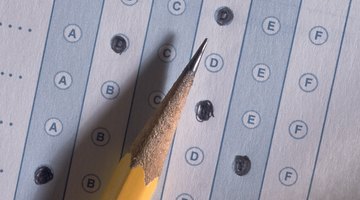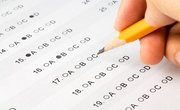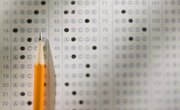The Stanford Achievement Test is a multiple-choice exam that measures student attainment in areas across the academic core curriculum: reading, language, spelling, listening, social science, mathematics and science. In some schools it's being supplanted by state-created tests as mandated by No Child Left Behind. Although the Stanford Achievement Test has been used for more than 80 years, it is not without detractors -- some parents and educators who would like to see it banned.
School Quality
Although a school's Stanford scores are often used as an indicator of its success, the test itself was not really designed to measure school quality. Since this test is meant for students all across the country, it takes a generic, "one size fits all" approach to knowledge and does not take into account how one school system's curriculum may differ from that offered by another system. This standardized test also cannot determine a school's standards for teaching and learning.
Teaching to the Test
When a school system places a great deal of emphasis on any standardized test, including the Stanford Achievement Test, this tends to narrow the focus of the curriculum in order that students may drill the information covered on the exam, at the expense of other subjects and areas that aren't included. If test scores are tied to teacher performance evaluations and salaries, this may result in teachers feeling pressured to "teach to the test," so they may rush through or even skip such subjects as state and local history that aren't covered by a nationalized exam.
Ineffective for Special Needs
Although the Stanford Achievement Test does make certain provisions for students with disabilities and those with limited English proficiency, these accommodations -- such as testing in small groups and simplified/repeated directions -- are frequently insufficient to overcome the challenges faced by students who may receive the bulk of their instruction outside of the regular classroom. In a 2011 article published by the "Journal of Deaf Studies and Deaf Education", authors Sen Qi and Ross E. Mitchell explained that many hearing-impaired students are often hampered in their language acquisition efforts, which tends to result in their scoring significantly below grade level on language-based subjects such as reading comprehension. Doctoral student Wayne E. Wright, in an article written for a 2002 issue of "Current Issues in Education," points out that standardized test scores of students who are still in the process of learning the English language don't really reflect their mastery of the subject matter, but only their ability to understand the instructions.
Cultural Bias
One of the strongest criticisms that standardized tests including the Stanford have faced over the years is that they are culturally biased. Minority students frequently do not score as high overall as do students from the dominant culture, which brings the validity of the tests themselves into question. The culture bias appears to be economically based as well, with the achievement gap between affluent and low-income students increasing by 40 percent since the 1960s. One distressing result of such test score inequality is that as the pressure increases upon schools and teachers to produce higher test scores, this may have the effect of increasing the dropout rate among poor and minority learners.











